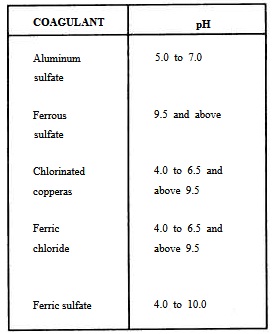because of its appearance and the taste and odors sometimes associated with it.
Turbidity is a muddy or unclear condition of water caused by particles of sand, clay, or organic matter being held in suspension. Clay and silt remain suspended in water for the longest period of time because of their particle size and specific gravities. The removal of turbidity is essential to the production of potable water. Removal reduces water contamination, extends the time between backwashing of filters, decreases chlorine demand, improves disinfection, and enhances user acceptability of the finished water. Proper water treatment requires turbidity removal because suspended particles often contain organisms that may cause diseases.
Turbidity is removed by coagulation and sedimentation. Since the physical characteristics of raw water vary widely in different locations, dosages of coagulant chemicals must be determined at each water point to ensure maximum efficiency with minimal waste of chemicals. After coagulation and settling, the water should not have more than 20 percent of the original turbidity. Daily jar tests will help check the optimum chemical dosage required to meet this standard.
COAGULATING CHEMICALS
The type of chemicals that should be used for coagulating raw water can be determined by using the results from jar tests, plant tests, or by using the data shown in table 9-3(A). Theoretically table 9-3(A) is correct; however, these values can be misleading when applied to some types of raw water. The chemical content of water may have a considerable influence on the optimum pH range for the various coagulants. For example, coagulation with ferrous sulfate is usually best accomplished at relatively high pH values in the alkaline zone. With soil, colored waters, ferric coagulant may sometimes be used with considerable success at pH values of 4.0 or less. Because of this wide variation in the optimum pH range of coagulant (caused by individual characteristics of the raw water), the coagulant dosage and the optimum zone for floc formation should be determined by jar tests, rather than just relying on table 9-3(A).
Table 9-3(A). - Optimum pH Ranges for Common Coagulant

JAR TEST
The jar test is the most common method of determining proper coagulant dosages. When there is a question as to which chemical should be used as a coagulant, it is often necessary to run more than one series of jar tests. Different coagulant chemicals and pH ranges should be used to determine which one produces the most satisfactory results at the lowest cost. The step-by-step procedures for ajar test are as follows:
1. Prepare a standard solution of eachContinue Reading
